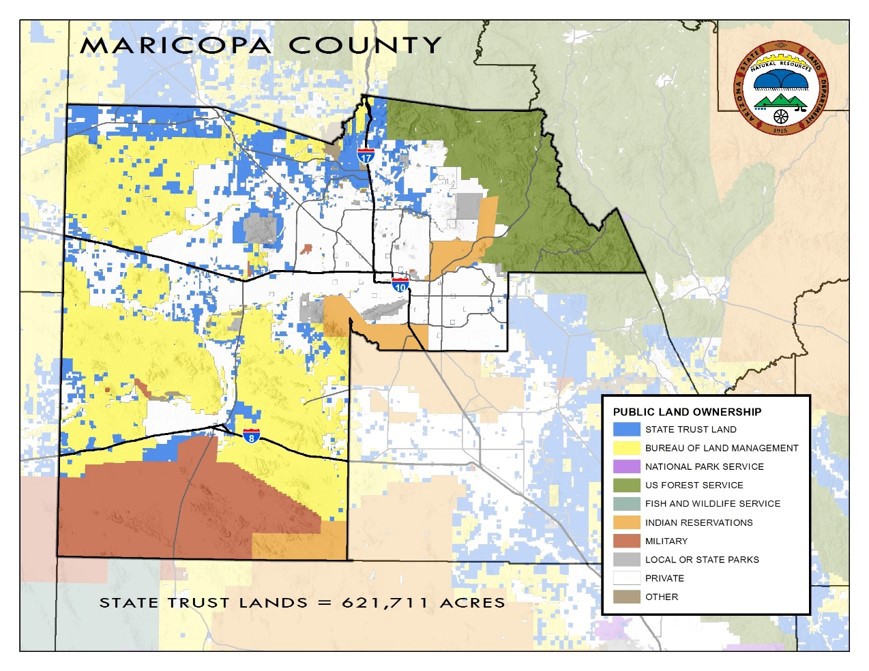Arizona State Land
December 1, 2017

LISA A. ATKINS
Commissioner, Arizona State Land Department
In 1910, the U.S. Congress passed the Arizona Enabling Act authorizing the Arizona Territory to prepare for statehood. Included in the 1910 Enabling Act were designated lands granted in Trust to the Territory of Arizona to assist with a base to support our common schools (K-12 education), higher education systems and other necessary governmental institutional needs of a new state.
The Congressional provision of the grant of lands in Trust limited disposal and use with restrictions designed to assist K-12 education and twelve additional defined beneficiaries in perpetuity. To ensure the perpetual nature of the Trust, Congress provided that any rent proceeds from Trust lands would be expendable and any sale of Trust lands, or royalty proceeds of products and minerals severed from Trust lands, would be placed in a permanent fund in the Treasurer’s office to be invested to earn interest. The earned interest is expendable – the Permanent Fund is currently larger than $5 billion.
The Arizona State Land Department (ASLD) was created by the Arizona Legislature in 1915 to be the fiduciary for the Trust assets – which today include more than 9.2 million acres of land across the state. In Maricopa County alone, there are more than 621 thousand acres.
Arizona’s Trust land is not public land, but a portfolio of Trust land and assets which are managed on behalf of the thirteen beneficiaries as a multi-generational, perpetual Trust. Arizona’s K-12 education system is the largest Trust Beneficiary holding more than 8 million acres.
The 9.2 million acres represent 13 percent of the land within the state, and are located throughout Arizona’s fifteen counties. Private land holdings in Arizona account for 14 percent of the state, and all other lands in the state are either owned or managed by the Federal government. Proactively managing the Trust portfolio in alignment with the best interests of the Beneficiaries and Arizona’s future, is an important factor in our state’s economic development potential.
Trust Land can be sold or leased. Surface leases include commercial uses, rights of way, grazing, and agriculture. Rights of Way leases exceed 7500 and cover almost 260,000 acres of land. Grazing and agriculture leases total just shy of 1,500 leases, but cover more than 8.5 million acres. Subsurface leases account for another 1.1 million subsurface acres and include more than 900 thousand acres of oil & gas – almost 30,000 acres of minerals.

In the last fiscal year (FY17) ASLD management of the Trust portfolio generated $281 million in revenue on behalf of the Beneficiaries, 32 percent of which went directly to the beneficiaries from lease payments and 68 percent to the Permanent Fund for investment.
ASLD is focusing efforts and resources on improving coordinated management with adjacent land owners/managers and customers of the Trust. We are continuously working on our internal processes to make business decisions that include all facets of the Trust, streamline processes to eliminate waste and improve our customer service.
ASLD’s entire application process is now conducted electronically which has reduced the Rights-of-Way and Commercial Sales process time. We are now making business decisions at the beginning of the application process, so we can work toward creating economic development opportunities that are good for both the Beneficiaries and our customers.
In addition to standardizing processes for greater efficiency and consistent decision-making, we are working to leverage and maximize partnerships with State and Federal agencies, as well as private industry. This will enable us to do a better job of landscape-scale treatments and enforcement of challenges like trespass and dumping in both urban and rural areas. Zoning bank agreements with local governments are allowing us to realize greater value for the Trust and improve our customer service in land sales. Forging partnerships with ADOT and organizations like MAG, CAG and PAG are allowing us to develop a well-panned infrastructure that is more cost-effective and will promote better development opportunities in growth areas.
We appreciate the interest and support of Arizona’s real estate community in the proactive, sustainable management of Trust assets throughout the state. We look forward to working with you.



